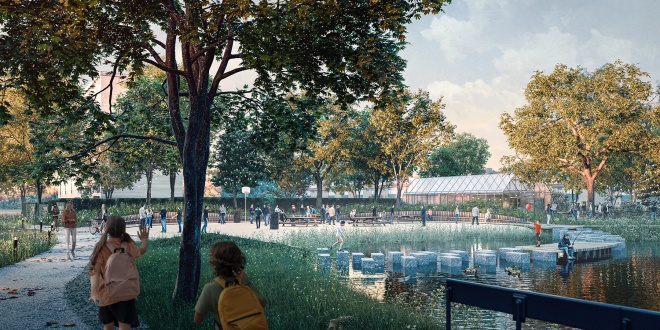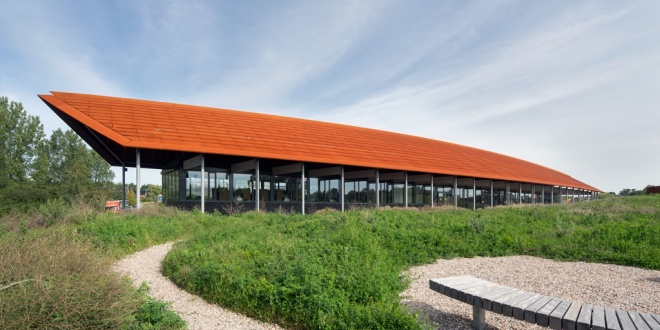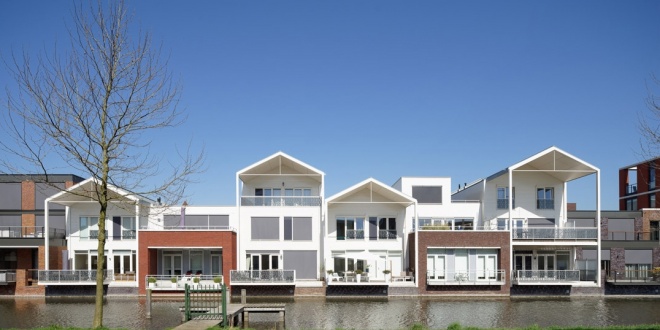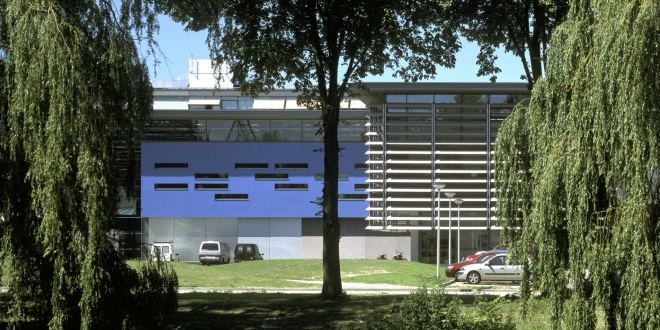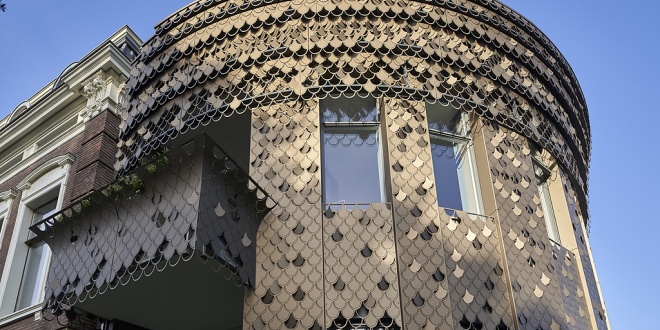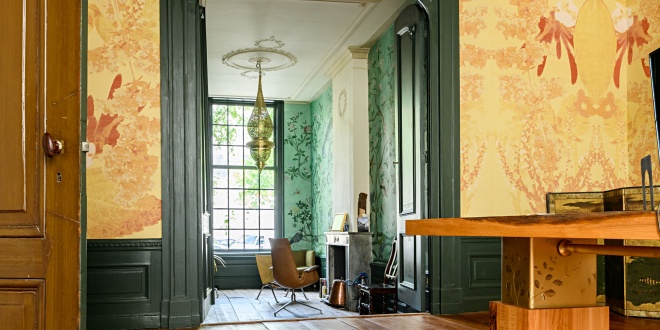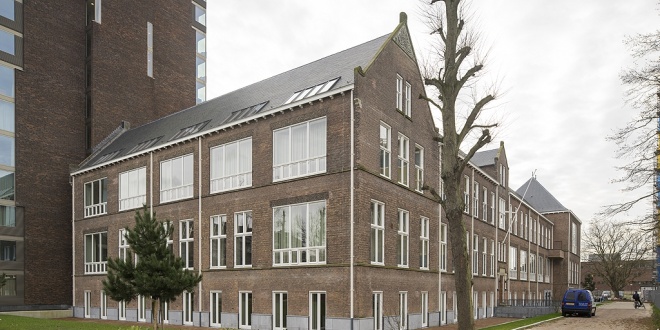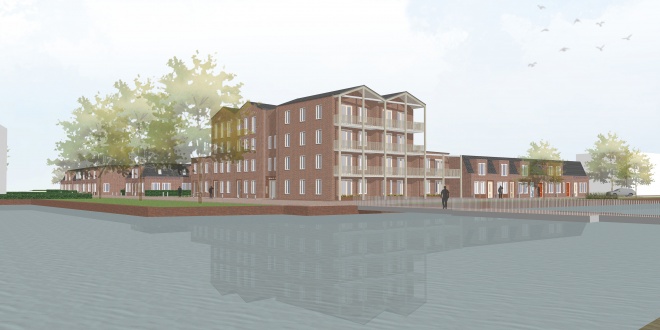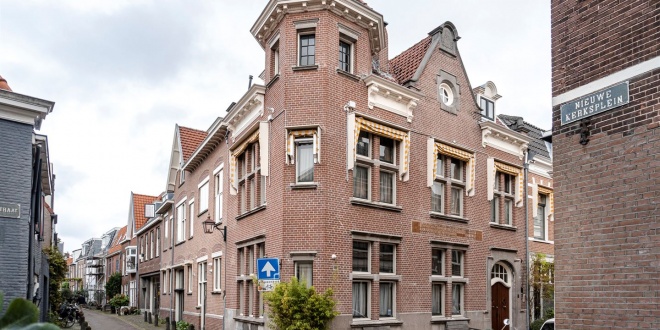In the summer of 2024, the municipality of Leiden launched an ideas competition for the Second Green Ring. Following the success of the Singelpark around the historic city center, the idea emerged to connect the parks and waterways along the city’s edge into one continuous whole — a green-blue ring where residents of the densely built city can recreate, exercise, experience nature, and meet one another.
Studio VVKH, together with partners in the fields of landscape architecture, water management, ecology, and industrial design, submitted a vision titled ‘Het Leidse Lint’ (“The Leiden Ribbon”). With this vision, we were among the three finalists invited to present their plans to a broad jury in March of this year. The citizens of Leiden were also able to view the proposals and share their opinions.
Our submission achieved second place. The winning proposal was ‘Panoramapark’ by Polyfern. We are proud of this result and greatly enjoyed developing our ideas for the city. The importance of outdoor space — for people, plants, and animals alike — will increasingly come to the forefront of design at all scales in the years ahead.
You can download the presentation boards of ‘Het Leidse Lint’ here.
The design team consisted of:
VVKH, Jan Maurits van Linge (landscape office Xi-ontwerp), Simon Akaya (npk design), Yasmin Stip (Stip werkt), Harma van der Meer (TU Delft), and *Ada Jaśkowiec.
House Hilde lies on the dunes, on the tourist route between Station Castricum and dunes. The building opened in January 2015 and combines a depot with a museum function. The archaeological center is named Hilde, a woman from the fourth century AD and found in 1995 during an excavation in Castricum.
Hilde house was commissioned by the Province of North-Holland. Every Dutch province is responsible for the preservation and exhibition of archaeological finds within its borders. The old depot of North Holland in Wormer was too small, the climate was bad manageable and it was only limited accessible to visitors. The building on the Zanderij in Castricum offers plenty of space for storage and exhibiting archaeological finds and collections.
Hilde house has a floor area of 4,480 m2 and is divided into a pavilion and an underground depot. The building is designed with the surrounding landscape. The draft refers to an old dune landscape (so called “nollen” landscape) that is much older than the current shifting sand dunes and can still be found at various places in North-Holland. In the aboveground elongated pavilion on the one side the main entrance, with desk, museum shop, and a space for temporary exhibitions, cloakroom and toilets are situated, on the other side the office staff. On the first floor is a small restaurant with terrace and auditorium. The elongated shape and the 70-meter roof of the building refer to the early medieval farms, as they have been in the area. The curved roof structure is finished with Corten steel sheeting as a reference to thatched farms. The large overhangs of the roof protect the interior from direct sunlight, which allows the use of large glass surfaces. The façade is decorated with stone from Morocco, fossil pintail squid in it, a reference to the archaeological feature of the building. This stone also comes back into the interior.
The depot is about 2,200 m2 and is divided into several archives and the centrally located exhibition space. The hilly “nollen” landscape is, as it were, pulled over the depot. By placing a meter of sand on top of this part of the building a stable climate is achieved in a passive way and only limited installations are necessary in order to maintain a constant temperature and humidity in the depot. By putting strong in design and construction on sustainability House Hilde has an average score of 8.6 on the sustainability label. In addition, the integration of buildings with the landscape certainly has a symbolic value: in the ground is the best place to preserve archaeological treasures.
The plan ‘de Biezenhof’ is part of the new residential area ‘Waterrijk Woerden’ and is situated along a natural watery region. The urban scheme of ‘Waterrijk Woerden’ was designed by West 8 and refers to the traditional Dutch water cities such as Delft and Leiden. The design is made in collabiation with Klunder architects. Almost every dwelling is individual and has a specific connection to the water.
The plan of Biezenhof is divided in two parts: there is one block of family houses around a courtyard on the edge of the lake, and there is a row of water houses and apartments along a canal.
The buyers of the houses could choose between several types of houses as well as between four architects. Due to the possibilities in combining type and architect, not one house is the same. Every house has a singular character: the lake houses have a beautiful view on the lake, the street houses have a garden, and the canal houses enclose big terraces. In the public space there are a few parking places, the majority of parking places are organised in garages.
The houses designed by Knappers are characteristic because of the huge roof overhanging the façade. This contributes to the shelter-against-the water identity of the houses, and refers to the greenhouse glass constructions in the low lands. At the street side these houses are made of brick, which gives them a closed and open (to the light and the water) individuality.
The new faculty OCP of Delft university of technology, accommodates the disciplines of Mechanical, Maritime and Industrial Design. During the constructionworks school continued. The new building shows a contemporary, logical and efficient architectural structure with it's own recognizable facade in the TU-district. The interior design is executed as an integral part of the whole plan.
The Plantsoen in Leiden is well known for the historical appearance of both the city park (1836) and the houses of the last quarter of the 19th century. The park was originally landscaped on the edge of the city in the place of an old defense belt. At the entrance of the park at the east side the monumental building Plantsoen 1 – 3 is redeveloped in a complex with 6 apartments. The apartments of about 150 m² are provided with all luxury and comfort, such as a private indoor garage, spacious roof terraces and an elevator, while retaining the historical look and value of the building. Redevelopment also applies to sustainability; obtaining Energy label A. Exterior facades, window frames and roof are additionally insulated. The houses are underfloor heated and solar panels are provided on the roof.
The municipal monument at Plantsoen 1 – 3 is divided over three floors and a basement. The property at number 1 was originally a fully detached house, number 3 was part of a block of 3 houses. Both buildings date from 1875 and were connected in 1957 and converted into one large nursing home. In this function change, the original qualities have largely been lost. The round expansion at number 1 dates from 1993.
In the new layout with 6 apartment, the monuments are restored to their former glory by restoration contractor Burgy from Leiden. The façade of the intermediate building is renewed and aligned with the monuments. The existing façade of the round building is finished with a bronze wall cladding, a ‘veil‘ with a leaf motif. This pattern is inspired by the leaf motifs and decorations of the 19th century, which can still be found in various places along the Plantsoen. The round with ‘veil’ becomes a special recognition point in the inner city.
Each apartment has both rooms in the monumental area as well as in the newer parts. The interior of the monumental buildings is provided with appropriate details to bring back the historical character as much as possible. This specific part is provided by Verlaan & Bouwstra architects from Vianen.
On the inside buyers have a lot of freedom of choice; they can choose for an even richer historical finish with wall tension, panelling and en-suite layout or a tight, modern finish and layout; both are possible. Each apartment is unique, has its own layout and its own character. Only the view is the same for all apartments; they all look out over the beautiful monumental city park the Plantsoen at the town canal.
The redevelopment was completed in July 2018.
For the residential house Rapenburg 49 in Leiden, a listed national monument, we designed a plan that both enhances sustainability and strengthens the building’s historical and spatial qualities.
The house consists of a front and rear section. The period rooms in the front house have been restored to their former glory — original details and colors were reinstated, and new wall coverings were applied. The family, with two children, lives in the rear house, which they wished to renovate as sustainably as possible.
By implementing a breathable insulation system, a new insulated ground floor, and an air-source heat pump, the rear house has been successfully taken off the gas grid. During the renovation, the layout was improved, and a dormer and several roof windows were added. The connections on the ground floor between the kitchen and living/dining room, and on the upper floor between the bedroom and library, were reinstated. In all interventions, a careful balance between modern technology and historical awareness was sought.
The project was realized in close collaboration with the client, restoration company Burgy, and Erfgoed Leiden.
Photography: Arjen Veldt
On the Boerhaave Campus, part of the Bio Science park in Leiden, the historical anatomy-building has been transformed into housing for Phd-students and researchers of the Leiden University. The new apartments are characterized by their high ceilings and old constructions. A small mezzanine is created to function as a bedroom. Right beside the existing building a new appartmentbuilding is erected, designed by Van Gameren of Mecanoo Architects. The total complex contains 166 apartments and is the first step in the complete transformation of the Boerhaave Campus.
Middelsee is the expansion plan on the southwest side of Leeuwarden, based on an urban design by West 8. The Frisian water city serves as a source of inspiration. Commissioned by the smallest housing association in the Netherlands, we have designed a plan for homes arranged around two green courtyards. It forms a small-scale community with plenty of space for encounters, and a robust waterfront with the apartment building as its eye-catcher.
Using simple means, variety is created so that no more than two houses are ever the same. The foundation remains consistent: a compact floor plan, lightly jointed red brickwork, and solid white window frames. We introduce variation through a dormer or a brick roof extension, a roof edge detail, or a distinctive entrance feature. The client’s existing housing stock in Leeuwarden’s city center also served as inspiration — a characteristic working-class neighborhood with abundant greenery.
In our plan, residents meet each other around private stoops and gardens bordered by low hedges, as well as along the wide galleries on the timber façade of the apartment building. Shared bicycle storage areas and shared cars also contribute to the sense of community.
In the heart of the Vijfhoek, a picturesque neighborhood in the historic center of Haarlem, stands a large building erected in 1908 by the Waaning company as a factory for Haarlemmer Olie. The building has since been designated a municipal monument. The section facing the Doelstraat originally served a representative function: richly ornamented office spaces were used to receive visitors and convince them of the remarkable qualities of this “miracle oil.” The rear section contained storage and staff quarters, adjoining an inner courtyard with the boiling room, where the sulphur-rich oil was produced a few days each year.
Since the 1980s, the building has been used as a residence. The division between the front and rear sections has been removed, yet the historic atmosphere remains tangible. The new owner asked us to develop a plan to prepare the entire building for a new century—energy-efficient, comfortable, and focused on the enjoyment of living, both along the street and around the inner garden. The boarded-up garage doors have been replaced with generous glazed folding doors. Using flax insulation, the building is insulated from within; new glazing is installed, and the roof is insulated from the outside. Heat pumps and solar panels provide sustainable energy generation. In close consultation with the Heritage Department, all characteristic elements are preserved—allowing the new residents to begin the next chapter in the rich history of this building.
In close collaboration with restoration contractor Burgy, EPOS Advies, and energy consultancy Kroon, a plan of approach was developed. Construction began in February 2024.





